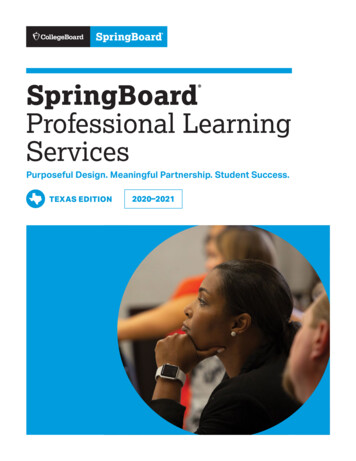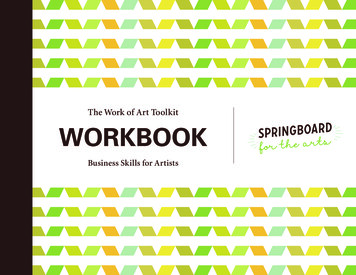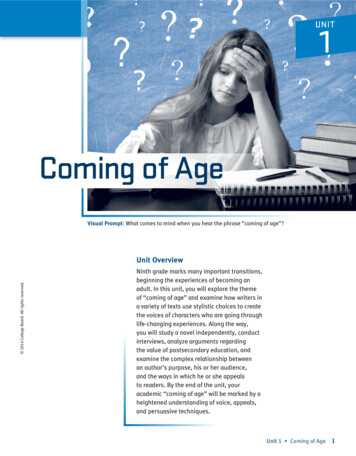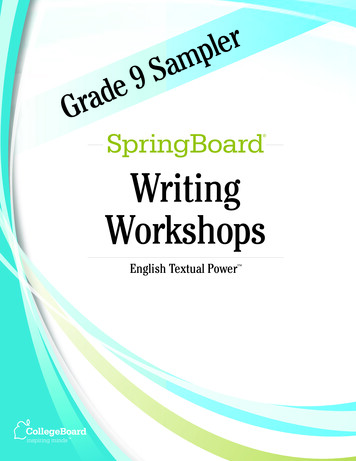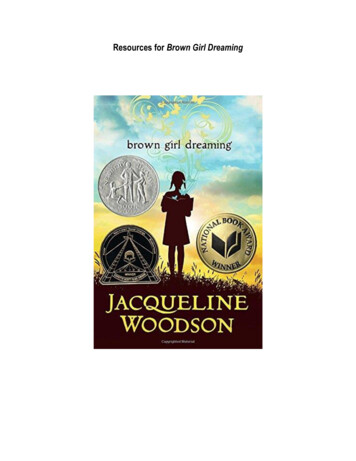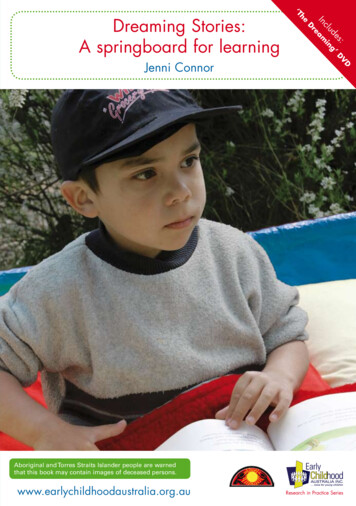
Transcription
InheDs: DVde g’clu minaDreJenni Connor‘TDreaming Stories:A springboard for learningAboriginal and Torres Straits Islander people are warnedthat this book may contain images of deceased persons.www.earlychildhoodaustralia.org.auResearch in Practice Series
About Early Childhood AustraliaEarly Childhood Australia actively promotesthe provision of high quality services for allyoung children from birth to eight years andtheir families, and supports the importantrole of parents. Early Childhood Australiais also the national umbrella organisationfor children’s services and a leading earlychildhood publisher.About the Research in PracticeSeriesThe Research in Practice Series is publishedfour times each year by Early ChildhoodAustralia.The series aims to provide practical, easy toread, up-to-date information and support to agrowing national readership of early childhoodworkers. The books bring together the bestinformation available on wide-ranging topicsand are an ideal resource for children’s servicesworkers and others interested in the careand education of young children.Series EditorJulian FleetwoodEdition EditorsStacey CamptonJim CastroGraphic DesignKate BrennanPhotographsCourtesy of Kura YerloChildren’s Centre andWoodville GardensPreschoolAndrew SikorskiAbout SNAICC and the SNAICCResource ServiceThe Secretariat of National Aboriginal andIslander Child Care, SNAICC, formallyestablished in 1981, is the national nongovernment peak body in Australiarepresenting the interests of Aboriginal andTorres Strait Islander children and families.In 2005 SNAICC received funding throughthe Australian Government’s Early Childhood- Invest to Grow Initiative of the StrongerFamilies and Communities Strategy toestablish a national Indigenous family andchildren’s resource service, which was officiallynamed the SNAICC Resource Service (SRS)in 2006.The SRS works across the family and children’sservices sector with Aboriginal and TorresStrait Islander community-based services andother services working directly with Aboriginaland Torres Strait Islander children to produceand distribute resources and information infour priority areas.The Dreaming Stories: A springboard forlearning RIPS publication fits under SRSPriority Area One: Early childhooddevelopment, parenting and child rearing.Early Childhood Australia Inc.PO Box 7105 Watson ACT 2602T: (02) 6242 1800 F: (02) 6242 1818Sales line: 1800 356 900 (freecall)E: eca@earlychildhood.org.au Copyright 2007All rights reserved byEarly Childhood Australia Inc. and SNAICCMaterial herein must not be reproducedin any form without the written permissionof Early Childhood Australia Inc. and SNAICC.Registered for posting as a publication—PP232100/00036ISSN 1440-5148ISBN10 1-921162-14-7ISBN13 978-1-921162-14-5Printed by Goanna, Canberra
ContentsiiAbout the author1Introduction4Understanding The Dreaming6Choosing the stories7Stories that appealed to young children15Stories for adults to mediate20Conclusion22References and further readingDreaming Stories: A springboard for learning
About the authorJenni Connor has worked as a teacher, principal, superintendent and curriculummanager. She has developed national and state documents on learning,curriculum and assessment, and managed Equity Programs for schools,including Indigenous education. She has worked at all levels of education, and ishighly regarded for her expertise in relation to young children and their learning.Jenni is currently teaching units for a new course in early education andcare at the University of Tasmania. She has written a number of publications,including co-authoring Early Childhood Australia’s Your child’s first year atschool: A book for parents.iiResearch in Practice Series Volume 14 Number 2 2007
Introduction‘Dreaming stories tell the origins of the environment, how the Spirit Ancestorsformed and gave life to the land and laid down the Law: structures of society,rituals to maintain the life of the land, rules for living. Above all, Dreaming storiesare the stories of the land, living with the land and belonging to the land’(SNAICC, 2005, p.1).‘Mainstream educatorswant to be certainthat materials relatingto Indigenous culturesand beliefs areauthentic, and theywant adviceon how to usethem appropriately.’Dreaming Stories were originally created by Indigenous communities, forIndigenous people. They play an important part in the cultural heritage of Aboriginaland Torres Strait Islander peoples because Indigenous values, responsibilitiesand spiritual beliefs are woven into the Stories. Since the Stories hold greatwisdom for us all, children from a range of cultural backgrounds can gain valuableunderstandings from them.Mainstream educators want to be certain that materials relating to Indigenouscultures and beliefs are authentic, and they want advice on how to use themappropriately. That is why The Dreaming series produced by Aboriginal Nations(www.ablnat.com.au) is such a valuable resource.As Keith Salvat, the series Producer, said: ‘As an education resource, The Dreamingseries is regarded as the most credible and informative product available toAustralian schools and educational institutions about Aboriginal and TorresStrait culture[s] ’Dreaming Stories: A springboard for learning
Aboriginal Nations produced 78 episodesof The Dreaming, an animation series basedon Indigenous storytelling. The stories aresourced from Aboriginal and Torres StraitIslander communities, in consultation withtheir Elders, and with permission for them tobe re-told and animated.A kit containing the stories on DVD and ateachers’ guide was distributed through theSecretariat of National Aboriginal and IslanderChild Care (SNAICC) in 2005.Sharing Indigenous stories with childrenprior to school ageIn 2006, SNAICC and Early Childhood Australia (ECA) wondered if some of thestories might be suited to younger children in childcare and preschool settings,so they initiated this research project. They thought the animation style of theproduction would appeal to young children, providing an introduction to Aboriginaland Torres Strait Islander cultures and beliefs, and a springboard for discussionabout significant values and ideas.As Josie Boyle, the narrator of two stories in this collection, tells us:‘When I go to schools and show these stories, both the black kids and the whitekids respond in a very positive way; even those children who do not normallyparticipate in class discussions do get involved and want to talk about the stories.‘When I visit preschools it helps to bond the children who are from different ethnicbackgrounds, because they all have a common response to the stories. They laughand see the fun and humour in many of the stories.‘For the black kids this is important because it helps the other children in thegroup understand their culture at a very early age. For the white kids it helps themunderstand the adventurous nature and the important things in Aboriginal culture.Generally there is a sense of pride that comes from the children that these storiesare about them and about their country.’SNAICC and ECA were interested in how educators in Indigenous and othersettings might use the stories for children’s learning. The result is this book, whichfocuses on young children, prior to school age. It complements the teachers’ guideSNAICC has distributed for Year One upwards and offers ideas for practitionersworking in the pre-school sector. Research in Practice Series Volume 14 Number 2 2007
Centres involvedThe centres that agreed to participate in the project were an open childcare centrein Darwin, a preschool with a culturally mixed population in South Australia, aMultifunctional Aboriginal Children’s Service (MACS) near Adelaide, two MACS inrural Victoria and an Aboriginal Child Care centre in northern Tasmania. Fourteenstories were chosen to trial in the six centres.Selected stories were copied onto DVD andsent to each location with a request that staff:‹ view them‹ show them to children‹ note children’s responses‹ document the activities they thoughtappropriate for the age groups,following the viewing‹ provide ‘words of caution’ about the suitabilityof particular stories for different age groups.Practitioners were invited to show the DVD toany of the children in the centre, but particularlyto engage children in the three–five age group inmaking meaning from the stories and respondingto them. This book records early childhoodeducators’ responses.Information arising from the research isorganised around:‹ brief synopses and interpretations of eachstory, derived from the original story narratorsand other research by this writer‹ key messages identified by centre staff andthis writer‹ comments from staff in early childhood settings‹ activities arising from the story, documentedby staff.Some stories were trialled in more than onecentre. The centres are not identified in connectionwith specific activities or comments.‘When I goto schools andshow thesestories, boththe black kidsand the whitekids respond ina very positiveway; even thosechildren whodo not normallyparticipatein classdiscussions doget involvedand want totalk aboutthe stories.’Dreaming Stories: A springboard for learning
Understanding The DreamingIt is important for educators to understandthat Dreaming Stories are not fairytales;they are not fictions made up to entertainchildren. One original purpose for Aboriginaland Torres Strait Islander traditional storieswas to lay down rules for living. DreamingStories also carry knowledge from onegeneration to another, about the world,the Law, society, and the life and deathof people.They are serious pieces of communication,with a serious purpose. Accordingly,educators have a responsibility to treat thestories with the same respect that theyreceive in Indigenous communities.Because they are complex vehicles forconveying important messages, the storiescan be interpreted at a number of levels(Sveiby & Skunthorpe, 2006).Level oneLevel twoA Story may relate to questions children mightask, such as ‘Why is some water salty?’It explains differences we see in the naturalworld and our responsibility to care for it.A Story may give lessonsabout people livingwithin a community;about sharing andthe responsibilities ofindividuals, leaders andcommunities; about rightand wrong ways of actingand the shame thatfollows from breakingthe Law.‘It is important for educators to understandthat Dreaming Stories are not fairytales; theyare not fictions made up to entertain children.’ Research in Practice Series Volume 14 Number 2 2007
‘They areserious pieces ofcommunication,with a seriouspurpose.Accordingly,educators havea responsibilityto treat the storieswith the samerespect thatthey receivein Indigenouscommunities.’Level threeA Story may explain the relationship betweena community and the larger environment: theearth and other Aboriginal and Torres StraitIslander communities. It may speak aboutthe careful maintenance of resources toensure the survival of plants, animals andpeople—or it may give advice about howto deal with disputes between members ofdifferent communities.Level fourNot all Stories have afourth level. When present,it relates to practices andceremonies that can beaccessed only by thosewho are initiatedthrough training and longexperience, and given theright and responsibilityto carry the Story and itsmeanings for the benefitof the community.Dreaming Stories: A springboard for learning
Choosing the storiesEducators reported that children under the age of threedid not fully engage with the stories they were shown,although they appeared to enjoy the animation style ofthe films.Children in the three–five age range were fascinatedby many of the stories and talked enthusiastically aboutthe ‘characters’, their actions and their consequences,often relating them to their own lives. Young childrenseemed most easily to understand stories featuringanimals and familiar landscapes and behaviours.Some educators commented that they were notcomfortable showing young children material containing‘violent’ actions. This is an individual, professionaldecision, and other educators said they felt theycould explain why people acted in the way they didand why it’s important to think about the consequencesof our actions.Some educators wondered if the abstract ideasin some stories might be beyond young viewers.They had in mind stories that tell about how thelandscape, sky and languages were made andthose that include the Spirit world.It is evident, however, from the reports reproducedin the fourth chapter that, with help from adults,children are able to make sense of many of thesophisticated ideas in these stories.Three stories were not trialled for the reasonsdiscussed above—consequently, they are notdiscussed in this book, but are on the DVD thataccompanies it. As always, educators need tomake decisions about the materials they use,taking into account the age of the children theywork with, their knowledge of the children, andtheir own understanding and experience. Research in Practice Series Volume 14 Number 2 2007‘Young childrenseemed most easilyto understandstories featuringanimals and familiarlandscapes andbehaviours.’
Stories that appealedto young childrenThe discussion that follows focuses on the six stories that educators foundrelatively easy to introduce to children in the three–five age range.Ngarntipi (Spinifex Pigeon) as told byJanet Nagamarra from the Warlpiri people(Tanami Desert, Central Australia)Ngarntipi, the Spinifex Pigeon, became lonely travelling back to her own country.She searched for damper seeds for days and nights, eventually creating thePindjirri seeds now used for damper. She tells the Warlpiri people they can gatherthe seeds; they make damper and the women perform the dance of theSpinifex Pigeon.About the storyThis story highlights the importance ofseeds for food and new life. It explains howseeds are carried by birds from place toplace and gives reasons for the markings onthe Spinifex Pigeon (created by her tears).The story emphasises the importance ofdance as part of rituals that communicatethe way to live and the relationship betweenpeople, animals and the natural world.Key ideas‹ Food gathering.‹ Women’s and men’s roles.‹ Seasons.‹ Ceremonies.CommentsThe children liked thisstory a lot. They listenedto it while passing seedsthrough their hands.They loved the feeling ofthe seeds and seemedengrossed in the story.Dreaming Stories: A springboard for learning
Related activities‹ Just like the Ngarntipi, we collected edible seeds. We broke the pods open andate the seed inside.‹ Children grew seeds and looked for other plants that propagate through seeddispersal. Children talked about and investigated the seasons. They talked aboutrain and how important it is for growing plants.‹ Children re-told the story in their own words and talked about how thingshappened and how the pigeon felt at different stages in her journey.Buduk and Bulaytj Bulaytj as told byAlfred Yangipuy Wanambi from the MarranguClan (Arnhem Land in the Northern Territory)Buduk and his wife Bulaytj Bulaytj lived in Arnhem Land when there was freshwater everywhere, even in the dry season. Bulaytj Bulaytj was a good wife, takingcare of Buduk and the camp. One day it was hot and she fell asleep. Buduk was soangry he secreted a liquid that turned the fresh water salty. Bulaytj Bulaytj punishedhim by turning him into a beetle that no-one will eat because it’s too salty. Sheturned into a wallaby, a tasty animal that people will eat. She managed to createone pool of fresh water that is still used by the people today.About the storyThe story explains how fresh and salt water came to be in Arnhem Land and howthe beetle and the wallaby were created. It reminds people which foods are goodto eat and which are not, and how sharing the workload makes for more successfulcommunities.Key ideas‹ Salt and fresh water.‹ Roles of men and women.‹ Work for mutual benefit.‹ Creation of animals. Research in Practice Series Volume 14 Number 2 2007
CommentsRelated activitiesThe children enjoyed thestory. The messages of‘treat people fairly and withrespect and don’t get angry’were discussed. The teacherasked: ‘Who were thepeople in the story? Whatkind of people were they?What did they do? What doyou think of what they did?’‹ Staff drew attention to the music usedin the film, and children found andused the rhythm sticks and percussioninstruments in the room.‹ Children were interested in thedidjeridu, and the teacher asked anauthorised community person to playfor them and also to talk about livingwith the land, finding water, etc.Tajeer-Tarnium as toldby Joy Murphy from theWoiwurrung Clan of theWurundjeri people (aroundthe Yarra River in Victoria)Tajeer-Tarnium is a mischievous orphan boywho hides the hunters’ waterbags and isturned into a koala.About the storyThe story explains the Law and what canhappen if you break it, because the Law ismade to keep society operating safely andin harmony. The story is gently and formallytold. The little boy is not judged harshlyby the teller. Traditional names and wordsare well-explained. The film is visually veryattractive.Key ideas‹ How the animal/totem Koala was made.‹ There are rules for living.‹ Don’t cause harm to others.CommentsYoung children enjoyed thestory and animation. Somechildren were concernedabout the punishment ofthe little boy. They talkedabout how other peopleshould have befriendedhim because he was anorphan, and have realisedthat he played tricks onlybecause he was boredand lonely. This was animportant discussion ofvalues. Many children inthe centre are in foster/grandparent care, so theidea of ‘family’ was treatedvery sensitively.The children wereinterested in the koala, ananimal they know; theydid not understand thesymbolic meanings: ‘ifhumans do wrong theybecome animals’.‹ Water is essential for survival.Dreaming Stories: A springboard for learning
‘The story explains the Law and what can happen if you break it, because the Lawis made to keep society operating safely and in harmony.’Related activities‹ Self and social development: talk aboutloneliness and including others. Talkabout feelings and relationships: whathappens if you do the wrong thing?‹ Communication and language: identifykey Aboriginal words, e.g. tarnucks(water vessels); list and discussalongside English words. Read relatedstories (e.g. Koala Lou) and extensionbooks about family and loneliness.‹ Understanding the world: discussresponsibility for the environment, planta garden and discuss the importance ofwater.‹ Diversity: discuss different family types.Ask children to name people who areimportant to them on a ‘family tree’. Ona map, highlight where the story comesfrom: discuss other Aboriginal storiesfrom other places.‹ Arts and creativity: provide materialsfor children to weave, and fallen barkfor them to include in collages. Maketarnucks and hang them from a gumtree.‹ Design and technology: test thetarnucks for holding water and try tomake one that carries water best.‹ Health: encourage children to re-tell thestory using climbing equipment. Walkto find a eucalypt, as in the story.10Research in Practice Series Volume 14 Number 2 2007
The Snake and the Goanna as told byJosie Boyle from the Wongi people(Western Desert cultures)Goanna and the Snake were once friends, playing chasing games and looking forfood to eat. Snake suggested they find ochre plants and paint themselves to bepretty like birds. Goanna did all the work because she had hands, crushing theochres and painting Snake. She realised there was no paint left for her and she’dstill be mainly brown. So they fought, and Snake bit Goanna so she hadto go to the medicine tree. Today, snakes and goannas still fight if they meet.About the storyThe story explains the differences children seein snakes and goannas. It emphasises sharingroles and working with members of your familyand community.Key ideas‹ Fairness and sharing work.‹ Selfishness and losing friends.‹ Bush medicine.‹ Camouflage.CommentsThe animation works particularly wellin this story. Children learned that thesnake can be colourful because it haspoison to defend itself; the goannaneeds to be brown as camouflageagainst predators. The story led todeep discussion about cooperation,and also about deceit and what theoutcomes of each form of behaviourmight be. It introduced the ideaof jealousy and how we can all bedifferent but equal. Children learnedthat if a friendship ‘goes wrong’, agrudge can last for a long time.‘The story explains thedifferences children see insnakes and goannas.It emphasises sharing rolesand working with members ofyour family and community.’Dreaming Stories: A springboard for learning11
Related activities‹ Self and social development: talk about friendship, bullying, difference, jealousyand fairness.‹ Understanding the world: investigate the desert and its animals. Compareanimals in one environment to those in another.‹ Communication and language: make a chart using the words for snake andgoanna in local Aboriginal language; use related Aboriginal stories and poems.‹ Diversity: talk about how we are all different and ‘beauty’ doesn’t make youbetter. Chart different species of snakes and goannas and their locations inAustralia.‹ Arts and creativity: put up examples of artwork created by Aboriginal peopleand discuss the different styles used. Ask children to make and paint a browngoanna, then put colour on a brown snake. Create a red desert backdrop andinvite children to make and add animals they know.‹ Health: talk about what to do if you see a snake. Play ‘chasings’ in pairs(one snake and one goanna). Investigate bush medicines.‹ Design and technology: ask children to use computer programs to designtheir own reptiles.The Butterfly as toldby Olga Miller from theButchulla people(Fraser Island, Queensland)During the First Time, when the land had justbeen made, Caterpillar came upon a small spiritcalled Birrave, who painted the flowers, trees andgrasses. Birrave looked tired, so Caterpillar helpedhim by carrying the paint pail. Willy Wagtail triedto trick Caterpillar, so he could eat him, but Spidergave Caterpillar beautiful wings so he couldfly away.About the storyThe story explains the natural cycles of birthand death. It encourages children to be kind.It reminds us to attend to the spirits and thenatural world.12Research in Practice Series Volume 14 Number 2 2007Key ideas‹ Help each other.‹ Life cycles.‹ Propagation ofplants.
CommentsRelated activitiesThis story was verypopular and able tobe enjoyed by childrenfrom three years old.It made them lookmore closely atthe natural world,and the older onesinvestigated the lifecycle of the butterfly.‹ Self and social development: play gamesthat involve cooperation and teamwork;discuss the messages about relationshipsand helping each other.‹ Understanding the world: investigatedifferent life cycles, explore thetransformations involved for the butterfly;visit a museum to explore their butterflycollection, investigate spider webs andwhy they are made.‹ Communication and language: identify andname, in local Aboriginal language, thecolours in the story, teach songs involvingcolours using words from Aboriginallanguages. Read The very hungry caterpillarand ask children to explain the sequenceof both stories. Make a big book telling thesequence of The Butterfly.‹ Diversity: locate the story and storytellerusing the map of Indigenous Australia(see Horton, 1996).‹ Arts and creativity: provide cellophane,paper and paints for children to createbutterflies.‹ Health: have children move to music ascaterpillars, butterflies, birds and spiders.Share edible berries.‹ Design and technology: using acomputer, discover the use of ochrewithin Aboriginal communities.‘The story explainsthe natural cycles ofbirth and death. Itencourages children tobe kind. It reminds usto attend to the spiritsand the natural world.’Dreaming Stories: A springboard for learning13
How the desert came to be as toldby Josie Boyle from the Wongi people(Western Desert cultures)This story talks about the earth when dinosaurs and giant animals roamed the land.The animals call a meeting to discuss the problem of over-population and limitedfood supply, and decide to drain water from their waterholes to make new lands.Then they found that many plants would not grow in the salt water and animalswere dying. However, some animals discovered that at certain times the desertblooms and you can gather berries and flowers. They discovered undergroundsources of fresh water.About the storyThis creation story is poetically told, with great attention to the language of thetelling, especially descriptive words, adjectives and adverbs. It explains how thedesert came to be and why only certain kinds of animals and birds can live there.Key ideas‹ Time and place.‹ Changes over time.‹ Adaptation.‹ Responsibility for theenvironment.‹ Indigenous knowledge ofliving with the land.CommentsChildren enjoyed the style of the film.They recognised and named many ofthe animals in the story. They likedthe dinosaurs best because many areat an age when they are fascinatedwith dinosaurs. Later, they can learnabout competition for food and space,adaptation and extinction, and why someplants and animals (and people) cansurvive in harsh environments.Related activities:‹ Teachers asked questions such as, ‘What animals did you see? What do youknow about dinosaurs? Why did they die?’‹ Children experimented with growing plants in salt water and pure water.‹ Children jumped like the animals they saw.‹ Children played with toy animals and made up stories.14Research in Practice Series Volume 14 Number 2 2007
Stories for adults to mediateThe following stories illustrate how, with adult help, even children aged four andfive years can think about complex ideas and develop new understandings aboutthe spiritual aspect of living a good life.Thukeri as told by VeenaGollan, from the Yaraldiclan of the Ngarrindjeripeople (River Murrayand Coorong region ofSouth Australia)The story tells of two tribal men who livedon the shores of Lake Alexandrina. Theycaught many bream, called ‘Thukeri’, butrefused to share them with a stranger. Thestranger put many bones in the Thukeri,so they could not be eaten. The men wereshamed and the group punished.About the storyThe traditional practices of Indigenouspeoples model a balanced way of livingwith the land. They did not deplete thebreeding stock and their harvesting practicessupported conservation. The men broke thiseco-farming rule, so they had to be punishedunder the Law.Key ideas‹ We can live off the land.‹ We should take only what we need.‹ We should share.‹ Everyone in your group is shamed if youdo the wrong thing.‘The traditional practicesof Indigenous peoplesmodel a balanced way ofliving with the land.’Dreaming Stories: A springboard for learning15
Related activities‹ The group created storymaps: children created imagesfrom the story (boats, peopleand the spirit) and advisedthe teacher how to place thepictures in sequence.‹ Children talked about how thestories made them feel andwhat feelings are portrayed inthe stories. They talked aboutthe significance of them toIndigenous peoples.CommentsChildren were captivated by thecombination of visuals, voice andstory. They easily understood themessages of not being greedyand sharing, and we used this toreinforce our centre’s values about‘sharing, cooperation and being fairto everyone’. In children’s block play,for example, we talked about lettingeveryone have a go and not leavinganyone ‘outside’ the group.A few of the younger children wereanxious about ‘the stranger’ in thestory. However, this proved a point ofvaluable discussion. Staff explainedthat, of course, children shouldn’t gowith strangers, but adults who don’tknow each other might talk together.One parent, with an Asian culturalbackground, provided wonderfulinsight and cross-cultural connectionswhen she reassured children: ‘Theyare the Aboriginal people’s spiritualAncestors, just as we have spiritualancestors who teach and guide us.’16Research in Practice Series Volume 14 Number 2 2007‹ Teachers explained thatthese stories are passeddown through generationsand are part of Indigenouscommunities’ values andbeliefs. We explored otherstories that are passed throughgenerations in the differentcultures present at the centre.‹ Children used blocks andcardboard boxes to makeboats. They built themcollaboratively and inventedcomplex stories to act-outin them.‹ Teachers provided naturalmaterials, paints and brushes,limiting children’s choicesto primary colours. Theyencouraged children to re-tellthe stories in paintings and toreflect on what they learnedeach time.‹ Children watched films aboutAboriginal painters and askedfor ‘fine brushes so we cando that’.
‹ Children were interested in ‘the fish only having bones’. Silver ‘scales’ wereprovided and children wove mats, cut out fish shapes and drew fish, placingscales on the bones.‹ Sharing emerged as a main interest from Thukeri, and other stories (such asShare said the rooster and Little red hen) and children acted these out. Childrenplayed a game with join-up blocks where the goal was to share your blockswith as many people as possible. This was the reverse of the competitive gamemusical chairs.Warringe in the sky astold by Steve Comeagainfrom the Yammatji people(Murchison River areaof Western Australia)A long time ago, there were no stars in thesky. It was just black. The creatures of theearth watched the sun rise and set and didnot wonder why. One day, the birds andanimals were astonished to see childrencoming down from the sky, gathering foodand playing. The trouble was that the skychildren ate so much of the bush tucker thatsoon there wasn’t enough for anyone.Mother Sun became worried and so shecreated a huge damper which turned a richorange-yellow as she raised it to the
settings might use the stories for children’s learning. The result is this book, which focuses on young children, prior to school age. It complements the teachers’ guide SNAICC has distributed for Year One upwards and offers ideas for practitioners working in the pre-school se






